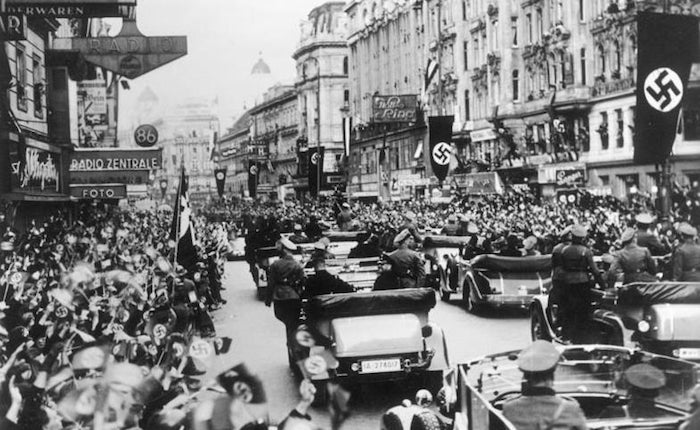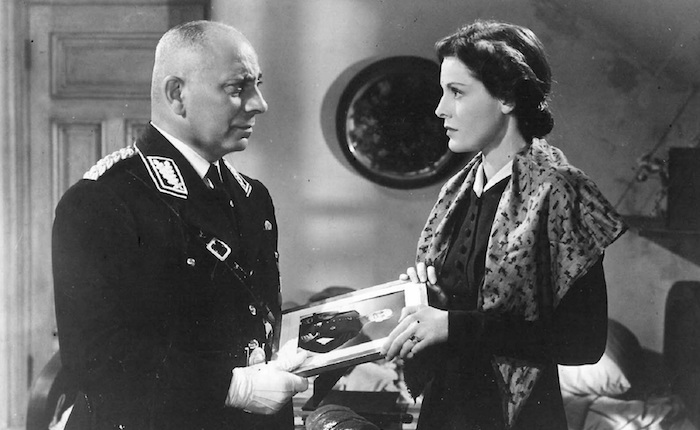Pathé newsreel
80 years ago, the beginning of the end for the independent nation of Austria was playing itself out, as Nazi Germany made its first move against a neighbor. On February 11, 1938, the Chancellor of Austria, Kurt von Schuschnigg, met secretly with Third Reich officials in Salzburg, arriving there by car from Vienna to not arouse suspicion. A day later he was taken across the border to Hitler’s nearby Berghof residence in Bavarian Obersalzberg, where he was served an ultimatum to resign in three days. Before he was allowed to go free, Hitler screamed at him what he would do to Austria if his demands were not met, and then forced him to lift the ban on the Austrian Nazi Party and its leader, Arthur Seyss-Inquart. Four days later, Schuschnigg named Seyss-Inquart Minister of Interior, giving the Nazis control over the police and the justice system, effectively allowing the Austrian Nazi Sturmabteilung (storm troopers) to run rampant, but he also called for a free plebiscite to decide Austria’s fate on March 13. But Hitler would not be denied. On March 12, German troops invaded Austria and were greeted by tens of thousands of cheering Austrians, as Schuschnigg resigned. Despite the country’s long history of anti-Semitism and its enthusiastic support of Hitler (himself an Austrian), the American government categorized Austria as an occupied country, which was also reflected in the anti-Nazi films Hollywood made during World War II.

German troops marching into Vienna
The first Hollywood film to address the Anschluss was Anatole Litvak’s Confessions of a Nazi Spy (1939), starring Francis Lederer. Throughout the film, the director inserts both real and recreated newsreel footage to illustrate Germany’s campaign of world conquest, including scenes of the Wehrmacht entering Austria at Weidenau (real), and Nazi storm troopers terrorizing Jewish citizens in Vienna (recreated), while the announcer states: “Hitler does not wait for certain defeat at the polls, he invades helpless Austria.” The speaker then notes the wave of suicides by well-known Austrians, including former Vice-Chancellor Emil Fay and philosopher Egon Friedell. Images of overwhelming German force thus solidified the impression that Austria was a victim of Nazi Germany, rather than the willing supporter it remained until the last days of the war, an impression reinforced by Frank Capra’s Why We Fight series, which takes a similar tact.

Erich von Stroheim and Frances Dee in So Ends Our Night (1941)
In contrast, So Ends Our Night (dir. John Cromwell, 1941), an independently produced adaptation of Erich Maria Remarque’s 1939 refugee novel, Flotsam, visualized the Anschluss somewhat more ambiguously. The film follows the fate of three refugees from Germany who are living illegally in Vienna, before they are caught and deported, eventually landing in France, where they likewise lead a shadow existence. The film’s narrator notes at the film’s beginning: “Without passports, these refugees had no legal right to live anywhere. They were forced to keep on the march – an endless march, interrupted only by arrest and imprisonment for illegal entry, then deportation into another country where the same fate awaited them… The story begins in Vienna in 1937, before the German occupation of Austria.” In the film, the anti-Fascist Steiner, played by Fredric March, is arrested and questioned by a Gestapo official, Brenner (played by Erich von Stroheim), indicating that the Austrian police were cooperating with the Nazis well before the invasion. Steiner even asks Brenner why he is allowed to act openly as a Nazi agent, to which Brenner replies that Austria will soon become a part of the Third Reich. The Anschluss itself is visualized by thousands of little swastikas hanging from the former Imperial palace (Hofburg), while Brenner rides through Vienna in an open car, just as Hitler would the day after the Anschluss. The Austrians are thus presented not as victims, but rather as active collaborators. Meanwhile, the film’s clearly expressed anti-Nazi sentiment would place the film in the crosshairs of isolationist American Senators, like Burton K. Wheeler of Montana, who in February 1941, a month after the film’s release, accused Hollywood of leading a “brutal propaganda campaign to drive America into war.”
At the Moscow Conference of the Allies in 1943, Austria was identified as the first free nation to be occupied by the Nazis, but Austrians were also to be held accountable for participating in Hitler’s war of aggression. As a result, Austria was divided into four zones of occupation after World War II (as was Germany), and remained occupied until 1955, when the Soviets finally agreed to withdraw, if Austria pledged eternal neutrality. However, Austrians were never held accountable for the Holocaust, nor were laws banning anti-Semitism ever passed. So now we again have a far-right government in Austria, a coalition between the Austrian People's Party and the Freedom Party, which was founded by openly anti-Semitic, ex-Nazis in 1956.
< Back to Archival Spaces blog






 Mobile Navigation
Mobile Navigation

